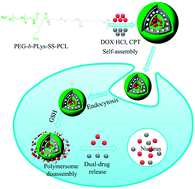Bioreducible polymersomes for intracellular dual-drug delivery†
Abstract
Stimuli-sensitive polymersomes, composed of amphiphilic

* Corresponding authors
a
Department of Polymer Science and Engineering, College of Engineering, Sungkyunkwan University, Suwon 440-746, Republic of Korea
E-mail:
jhpark1@skku.edu
Fax: +82-31-290-7309
Tel: +82-31-290-7288
b Graduate School of Health Sciences and Technology, Sungkyunkwan University, Suwon 440-746, Republic of Korea
Stimuli-sensitive polymersomes, composed of amphiphilic

 Please wait while we load your content...
Something went wrong. Try again?
Please wait while we load your content...
Something went wrong. Try again?
T. Thambi, V. G. Deepagan, H. Ko, D. S. Lee and J. H. Park, J. Mater. Chem., 2012, 22, 22028 DOI: 10.1039/C2JM34546C
To request permission to reproduce material from this article, please go to the Copyright Clearance Center request page.
If you are an author contributing to an RSC publication, you do not need to request permission provided correct acknowledgement is given.
If you are the author of this article, you do not need to request permission to reproduce figures and diagrams provided correct acknowledgement is given. If you want to reproduce the whole article in a third-party publication (excluding your thesis/dissertation for which permission is not required) please go to the Copyright Clearance Center request page.
Read more about how to correctly acknowledge RSC content.
 Fetching data from CrossRef.
Fetching data from CrossRef.
This may take some time to load.
Loading related content
